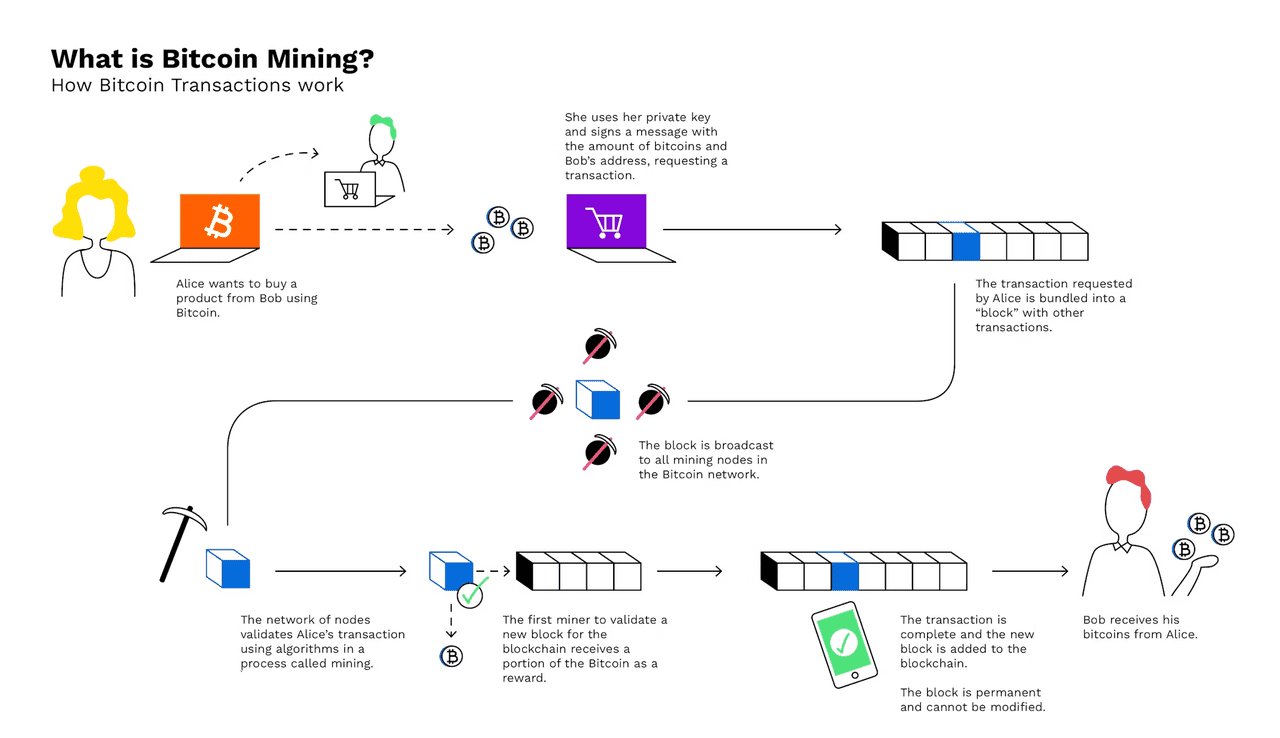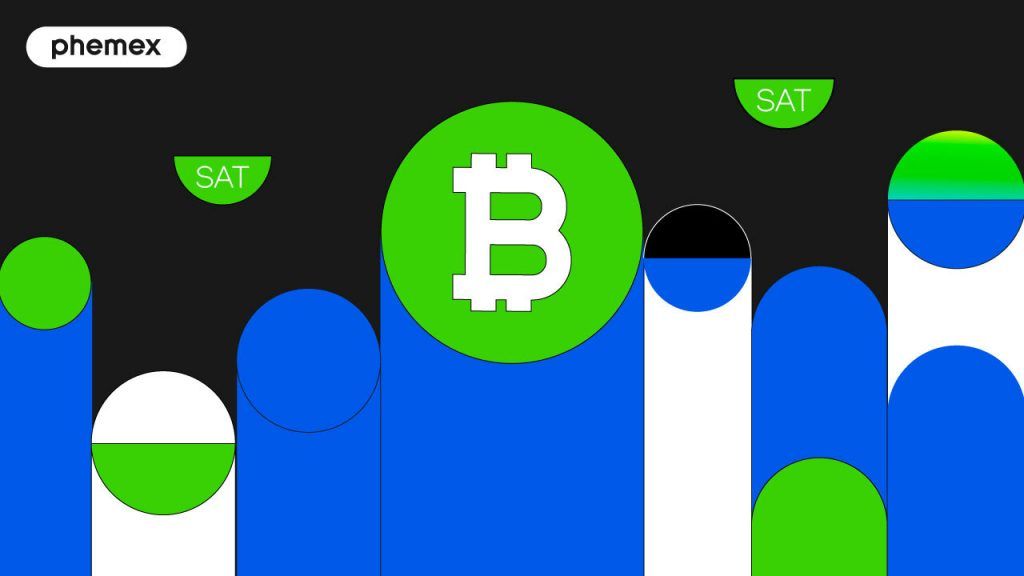Summary:
-
Bitcoin mining is the process by which powerful computers solve complex cryptographic puzzles to add new transaction blocks to the Bitcoin blockchain. Successful miners are rewarded with newly minted bitcoin (the block reward) plus any fees in the block. Importantly, the block reward was cut in half at the 2024 halving, so miners now earn 3.125 BTC per block (down from 6.25).
-
Bitcoin mining has changed over the years. Initially lucrative for at-home mining, increase in competition and thus computational power have made it harder to make a profit without specialized equipment.
-
Large industrial facilities with thousands of ASIC miners now dominate the network’s hashrate, which reached nearly 1 zettahash per second (about 980 EH/s) by mid‑2025. This enormous computing power keeps Bitcoin secure, but it also makes solo mining from home extremely unlikely to solve a block.
-
Nevertheless, home Bitcoin mining remains possible for hobbyists and enthusiasts who use efficient ASIC hardware and join mining pools.

What Is Crypto Mining?
Mining Bitcoin (BTC) was one of the early draws of crypto–the idea that you could make money by simply leaving your computer running to mine Bitcoin at home, was akin to printing money.
However, Bitcoin mining was not designed to make people rich, it was simply the consequence of a need to secure a trustless network in the absence of the usual centralised authority like a bank.
The basic concept of mining is that miners, who are based all over the world, use computing power and hardware to solve complex cryptographic puzzles in exchange for Bitcoin rewards. The solving of these puzzles is essential for the continued decentralisation of any proof-of-work (PoW) network, such as Bitcoin.
However, as Bitcoin grew in popularity, so did the competition to mine it. More powerful and expensive equipment meaning miners with less funds have been cut out and those with more have begun to dominate Bitcoin mining—resulting in a real threat of centralization.
A Brief History of BTC Mining: From Home to Business
Mining Bitcoin at home was at the core of Bitcoin founder, Satoshi Nakamoto’s, vision for a fair network. However, as computation power needs grew, so did the hardware and price point for mining Bitcoin at home.
Here’s how things evolved:
- CPU: Central processing units, like those we have in our home computers, were the first to be used for mining. This was possible as competition was low and there was no need for immense computational power.
- GPU: Graphics processing units were the next step for Bitcoin miners at home to increase mining efficiency with powerful graphics cards, as mining competition increased.
- ASIC: Application-specific integrated circuits represented the transition from home mining to full-blown commercial ventures as businesses filling up entire warehouses with specialized mining equipment. ASICs are built specifically for mining and can target specific coins, focusing all their energy on solving the cryptographic puzzles in order to secure the reward, in this case, BTC.
Today, many cryptos, such as Ethereum (ETH), Monero (XMR), and Vertcoin (VTC), are, or are fighting to be ASIC-resistant cryptos so that independent home miners will not be priced out of the market.
In addition, different hashing algorithms and consensus protocols are being implemented to bring back decentralization and re-encourage Bitcoin mining at home.

Bitcoin mining has changed a lot over the years. Today, Bitcoin mining with real profit comes in the form of warehouses filled with ASICs. (Source: Asiatimes.com)
Essential Hardware for Mining Bitcoin at Home
To mine Bitcoin at home, you need three basics: a Bitcoin ASIC miner, a robust power supply, and a connection to the network. In practice, the main component is an ASIC mining machine. These are purpose-built computers (often containing many chips) designed solely to do SHA-256 mining. Popular models in 2025 include Bitmain’s Antminer series and MicroBT’s Whatsminer series, among others. For example:
-
Bitmain Antminer S21 Pro – ~234 TH/s hashrate, 3,510 W power.
-
MicroBT Whatsminer M66S – ~298 TH/s hashrate, 5,513 W power.
-
Canaan Avalon A1566 – ~150 TH/s, 3,225 W.
Modern ASICs often exceed 200 TH/s and draw several kilowatts. Efficiency is measured in joules per terahash (J/TH); the above examples achieve roughly 15–22 J/TH. Lower J/TH (more hash per watt) means cheaper electricity per hash. You should compare these metrics (hashrate, wattage, cost) when choosing a miner. Specialized mining machine retailers list the latest models and specs. Because ASIC miners draw high current and heat, you also need a heavy-duty power supply (often included or sold separately) capable of the requisite wattage (typically 1600–2000 W or more per unit).
All this hardware must be housed safely. A simple home rig might be just one ASIC unit (box ~2 ft x 1 ft x 1 ft) mounted on a shelf or in a ventilated room. The miner needs an Internet connection (Ethernet is preferred for stability). A typical ASIC provides a web interface for configuration and monitoring. Before powering on, ensure you have sufficient electrical capacity: an ASIC that draws 3 kW requires a 240V line and ~15–20 A circuit. Many home miners upgrade a circuit or use a high-power outlet (e.g. a 20A L6-30R) to handle the load. Make sure not to overload your wiring: as a guide, never exceed ~75% of a circuit’s capacity.

A map of BTC mining costs according to electricity costs from August 2022. To view a more high-res image, click here (Source: visualcapitalist.com)
Step-by-Step: Setting Up Your Home Bitcoin Mining Rig
Once you have your hardware, setting up the miner involves a few steps. This procedure is similar whether you plan to mine solo or via a pool, with differences only in the final configuration details. A typical sequence is:
-
Unbox and Inspect: Carefully unpack the ASIC miner(s). Check for any damage, loose components, or bent heat sinks. Confirm that all fans spin freely.
-
Place Miner and PSU: Mount the miner on a sturdy rack or table in a well-ventilated area. Connect the power supply units to the miner (many ASICs have one or more dedicated PSUs, so follow the manufacturer’s instructions carefully).
-
Power It Up: Plug the PSU(s) into your electrical supply. (Often miners use a 240V input; ensure you have the proper outlet and wiring.) Power on the miner. Fans should start, and the device will boot up.
-
Connect to Internet: Use an Ethernet cable to connect the miner to your router or switch. (Avoid Wi-Fi for reliability.) The miner will obtain an IP address from your network.
-
Update Firmware: It’s often recommended to check for and install the latest firmware on your miner before heavy use. New firmware can improve stability and efficiency. Refer to the manufacturer’s website for instructions.
-
Log In to the Miner: On a computer, open a web browser and navigate to the miner’s IP address (often printed on the device label or found via DHCP logs). Log in using the default credentials (change these for security).
-
Configure Mining Details: Here’s where you enter your mining choices: pool or solo, and wallet details.
-
If joining a mining pool, you’ll usually enter the pool’s URL, your worker name/ID, and your Bitcoin wallet address (for receiving payouts). Different pools have different stratum servers (addresses) and port numbers; follow the pool’s guide.
-
If mining solo, you’ll enter settings for connecting to your own full node (Bitcoin Core) – the details depend on your node setup (RPC user/password, etc.). Solo mining is difficult for home users due to low probability of finding a block, so most beginners use a pool.
-
-
Start Mining: After configuration, apply the settings and watch the miner’s status page. It should show your hashrate and share submission rate. Make sure everything looks stable and that there are no recurring hardware errors.
After this, your miner is working. It will continuously perform hash computations and submit shares to the pool (or work on blocks if solo). Monitor the interface to ensure the hashrate is close to the advertised specification and there are few rejected shares. Typical setup software includes CGMiner or its GUI derivatives (many ASICs have web-based firmware that obviates the need for separate software on your PC). Having the miner’s interface and pool dashboard gives you real-time feedback on its performance and any payouts.
Pool Mining vs Solo Mining (and Cloud) for Bitcoin
There are three main ways to participate in Bitcoin mining: solo, pool, or cloud.
-
Solo Mining: You run one or more miners on your own and try to find blocks independently. The upside is that if you do find a block, you keep the entire 3.125 BTC reward. The downside is that with today’s massive network hashrate, a single home miner has an extremely tiny chance to solve a block in any reasonable time. (For example, a mid-range ASIC might take thousands of days on average to find a block solo.) Most home miners abandon solo due to this long “deadzone.”
-
Pool Mining: Instead, most people join a mining pool, which is a group of miners that share their computing power and split rewards. Pools have many participants; whenever the pool as a whole finds a block, the 3.125 BTC (plus fees) is shared among all contributors proportionally to their hashpower. This yields small but steady payouts (typically daily or weekly) rather than a rare jackpot. The pool will charge a small fee (often ~1–4%) for this service. In practice, pool mining is recommended for home miners because it smooths out the income. For example, at least 60% of the Bitcoin network’s hashrate currently belongs to just two pools (Foundry USA and Antpool), indicating how popular this approach is. To join, you simply sign up for an account on a pool site (like F2Pool, SlushPool, etc.), and enter the pool URL, worker ID, and your wallet address into your miner’s settings. Pools will then send you frequent small bitcoin payouts.
-
Cloud Mining: This is when you rent mining power from a remote data center (you pay them for hashing services). It avoids buying and running hardware yourself, but beware: cloud mining contracts can be scams or low-return, since you must trust the provider and pay fees. Generally, cloud mining is not recommended for beginners unless you fully trust the company and understand the contract terms.
For home mining, pool mining is usually the best option. It gives predictable results and avoids the astronomical luck needed to solo mine on a tiny rig. If you do mine in a pool, any Bitcoin earned goes directly to your specified wallet address automatically (either at a set threshold or on a schedule determined by the pool).
How to mine crypto at home: BTC rewards through altcoin mining
Some mining pools allow you to mine altcoins (cryptocurrencies other than Bitcoin) in exchange for BTC rewards. For example, using the Bitcoin Payout Feature, which is found on mining pools such as 2Miners, miners can mine crypto including Ethereum Classic (ETC), ERGO (ERG), and Raven (RVN) in exchange for rewards in BTC.
The process is simple, with miners just changing their payout wallet from the crypto in question to a BTC wallet.
With these cryptos receiving increased attention since Ethereum became un-minable, thanks to its merge and switch to a proof-of-stake (PoS) consensus protocol, now could be a good time to mine them. This is because increased attention will mean an increase in miners in the pool, meaning faster mining.
Calculating Bitcoin Mining Profitability in 2025
A crucial step before investing in a mining rig is to estimate profitability. Mining profit depends on many factors: your miner’s hashrate, power draw, local electricity price, pool fees, Bitcoin’s price, and network difficulty. Roughly speaking, you can calculate daily earnings as:
Daily Revenue ≈ (Your Hashrate / Total Network Hashrate) × (Blocks per Day) × (Block Reward) × (Bitcoin Price)
Then subtract your energy cost:
Daily Electricity Cost = (Power in kW) × 24 h × (Electricity price per kWh).
For example, assume Bitcoin is $116,000 and block reward is 3.125 BTC (≈$362,500). There are 144 blocks per day, so total new BTC per day is 450 BTC (~$52.1M at current price). If the network hashrate is ~926 EH/s (that is 926×10^18 H/s), then each TH/s (10^12 H/s) of your power would earn only about 450 BTC/day ÷ (926×10^6 TH/s) ≈ 0.000000000485 BTC per TH per day. In practice, calculations are easier using online calculators or spreadsheets.
For a real-world sense, consider a modern example from a mining profitability calculator. Using a miner at 390 TH/s (drawing 7,215 W) at $0.05/kWh and Bitcoin $115,868, the calculator shows: about 0.00018942 BTC per day ($22) in revenue, $8.66/day in electricity, yielding ~$13.29/day net (about +60% profit margin). At that rate, the machine would take over 1,000 days to recoup its $13,699 cost. If electricity were higher (say $0.10/kWh), costs would double ($17.32/day) and profit shrinks. Conversely, if Bitcoin price rises or efficiency improves, profits grow.
More generally, profitability can be thin. One analysis notes that miners overall produce about $20 million of Bitcoin per day, but that’s split among all machines worldwide. Meanwhile, a home miner might pay hundreds to thousands of dollars up front for hardware, and $100–$500 per month in electricity. In fact, macroeconomic data suggests the average cost to produce one bitcoin (at various electricity rates) is on the order of $80,000–$100,000 by mid-2025, roughly 80–90% of the price. In practical terms, this means only miners with very cheap electricity or cutting-edge efficient rigs turn a profit. At a more typical price of $0.10/kWh, one writer estimated it costs ~$11,000 of electricity to mine one Bitcoin. (Renewable-rich regions with sub-$0.05/kWh power might cut that cost to $5,000–$6,000.)
Key factors for profitability:
-
Electricity Rate: This is usually the biggest expense. Every watt your miner draws adds to your bill. For example, an ASIC using 3 kW continuously at $0.10/kWh costs $7.20 per day just in power. Reducing this cost (using very low rates or renewables) can make or break profitability.
-
Hardware Efficiency: More hash per watt improves revenue per kWh. For instance, an ASIC at 20 J/TH (50 TH/kW) will use more electricity per hash than a 15 J/TH unit, making the latter more profitable for the same hash.
-
Bitcoin Price: All mining rewards are in BTC. If Bitcoin’s price rises, your BTC rewards are worth more in USD, boosting profit. If price falls, mining revenue falls accordingly.
-
Network Difficulty: As more miners join, difficulty rises, reducing your share of blocks. Difficulty adjusts periodically, so historical averages may not hold.
-
Initial Cost: ASIC machines can cost anywhere from a few hundred to over ten thousand dollars. Higher upfront cost means longer payback.
Because these variables change, use an online mining profitability calculator (enter your miner’s hash and power, electricity cost, etc.) to get estimates. Tools often allow you to plug in current difficulty, Bitcoin price, and hardware specs to see daily/weekly/monthly profits. Update calculations as you go – for example, after each halving the reward halves, so revenue typically drops unless price or difficulty shifts.
Example of Bitcoin mining profitability calculation (source)
Conclusion
Mining Bitcoins at home is no longer as lucrative as it once was. Increases in energy needs alongside an energy crisis in the wake of war and general lessening of resources have meant that energy costs are soaring. Combine this with the current bear market and the investment hardly seems worth it.
However, if you are in for the long run and believe that Bitcoin will be on the up again soon, then Bitcoin mining could well be a good option for you. When the price of Bitcoin rises against the cost needed to mine, mining profit will rise as well.
So, what do you need to mine Bitcoin at home? If looking to get started in Bitcoin mining today, the safest option is to invest in the most powerful mining equipment available to you and to then join a mining pool, as well as mine altcoins for BTC alongside it. Mining pools may mean sharing rewards, but mining solo may mean no rewards at all.
Read More
- What is Crypto Mining & How does it Work?
- What are Crypto Mining Rigs: An Overview of ASIC, GPU and CPU Miners
- What is Bitcoin: World’s Largest “Group Project”
- What is Cloud Mining: The Cheaper Method for Bitcoin Mining
- What is Mobile Mining: Mine Crypto on A Phone
- Supply and Demand of Bitcoin: How Many Bitcoins Are There?
- What Are Mining Pools: The Massive Cooperatives That Power Blockchain













